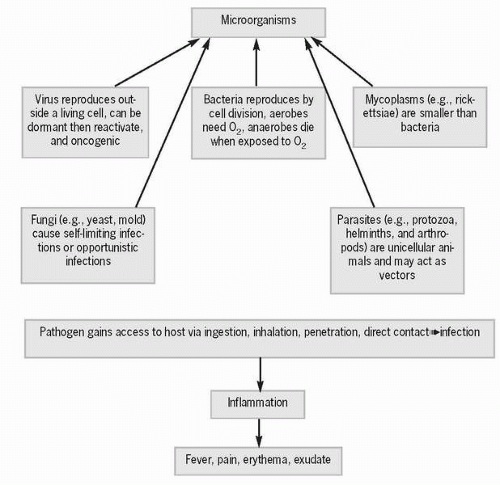Infectious Microorganisms
Many microorganisms live on the internal and external exposed surfaces of the human body without causing harm. When the normal balance of microorganisms is disrupted or the body is subjected to noncolonized virulent microorganisms that cause injury or pathological changes, an infection results. Viruses, bacteria, mycoplasmata, fungi, parasites, rickettsiae, and chlamydiae are some of the common organisms associated with the infectious process.
TERMS
Viruses are the smallest pathogens; they can reproduce outside of a living cell and are composed of a protein coat that surrounds a nucleic acid core of either ribonucleic acid (RNA) or deoxyribonucleic acid (DNA). Some viruses (e.g., herpes virus) are continually shed from the infected
cell’s surface, whereas others cause the host cell’s death during replication. A virus may remain dormant after host cell invasion only to replicate and produce symptoms of the disease months or years after the initial infection. Some retroviruses that belong to the oncogenic group are capable of transforming normal cells into malignant cells during their replication process.
cell’s surface, whereas others cause the host cell’s death during replication. A virus may remain dormant after host cell invasion only to replicate and produce symptoms of the disease months or years after the initial infection. Some retroviruses that belong to the oncogenic group are capable of transforming normal cells into malignant cells during their replication process.
Bacteria contain both RNA and DNA, have a rigid cell wall, and reproduce by cell division. Spore production allows survival in a latent state until growing conditions are favorable. Aerobes require oxygen for growth and metabolism, whereas anaerobes die when exposed to oxygen. The shape of the cell wall identifies the bacteria as coccus (i.e., spherical), spirillum (i.e., helical), or bacillus (i.e., elongated). Some bacteria have flagella, which are whip-like appendages that allow them to move through blood and lymph fluid. Gram-positive bacteria acquire a purple stain when exposed to a basic dye, whereas gram-negative bacteria do not accept the stain.
Stay updated, free articles. Join our Telegram channel

Full access? Get Clinical Tree




